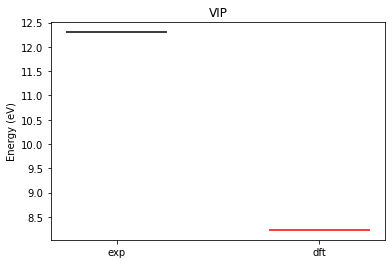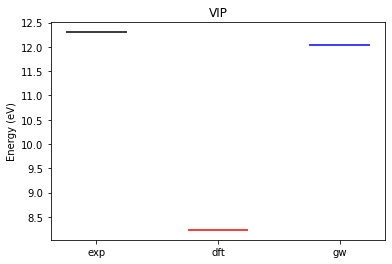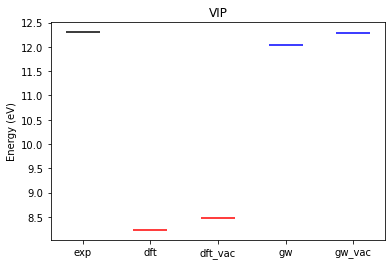MICCoM School 2017 Ex#1 : The VIP of SiH4
We are going to compute the Vertical Ionization Potential (VIP) of the silane molecule using DFT@PBE and GW.
The VIP is the minimum amount of energy that is needed in order to remove an electron from a molecule. When the removal does not take into account ion relaxation processes (change of molecular geometry), the ionization is said to be vertical.
The experimental value for the VIP of silane is tabulated in the NIST chemistry webbook: http://webbook.nist.gov/chemistry/form-ser/.
- VIP of silane = \(12.3\, eV\) (experimental value)
We would like to compute the VIP of silane from first principles using DFT and GW. ~
Let’s see which level of theory performs better.
1.1 : DFT calculation
We are going to numerically solve the Kohn-Sham equations for valence electrons only. Electronic wavefunctions and single particle energies are obtained by solving the secular equation:
\begin{equation} H^{\text{KS}}[\rho] \, \psi_n = \varepsilon_n^{\text{KS}} \psi_n \end{equation}
The Hamiltonian of \(N\) interacting electrons is formed by the following terms:
\begin{equation} H^{\text{KS}}[\rho] = T + V_{\text{ion}} + V_{\text{Hartree}}[\rho] + V_{\text{xc}}[\rho] \end{equation}
where \(T\) is the kinetic energy, \(V_{\text{ion}}\) is the electron-ion potential, \(V_{\text{Hartree}}\) is the Hartree potential, and \(V_{\text{xc}}\) is the exchange-correlation potential.
Note that the secular equation needs to be solved self-consistenly since the operator that we are diagonalizing depends on the eigenvectors (\(\rho = \sum_n |\psi_n|^2\)).
In this implemenation of DFT we are going to use plane-waves as basis set. This means that an electronic wavefunction \(\psi_n\) is obtained by computing the coefficients \(C_n\) of the plane-waves expansion:
\begin{equation} \psi_n(\mathbf{r}) = \sum_{\mathbf{G}} C_n(\mathbf{G}) e^{i\mathbf{G}\cdot\mathbf{r}} \end{equation}
In this way the kinetic energy of an electronic wavefunction will be obtained as \(\sum_{\mathbf{G}} \left| C_n(\mathbf{G}) \right|^2 G^2\). The total number of plane-waves is determined once we specify the size of the simulation box and the kinetic energy cutoff.
The electron-ion potetial \(V_{\text{ion}}\) is solved separately for each given atomic species. Pseudopotential files contain this information (previously computed) are typically loaded at the beginning of the calculation. Pseudopotentials can be downloaded from several websites, for instance:
SG15 : http://www.quantum-simulation.org/potentials/sg15_oncv/
Quantum ESPRESSO : https://www.quantum-espresso.org/pseudopotentials/
Note that we will be using only Norm-Conserving pseudopotentials (i.e., no Ultrasoft or PAW).
The Hartree potential is determined self-consistely as \(V_{\text{Hartree}}(\mathbf{r}) = \int d\mathbf{r^\prime} \rho(\mathbf{r^\prime}) \frac{1}{|\mathbf{r}-\mathbf{r^\prime}|}\).
The exact form for the exchange and correlation potential is unknown, many approximations are available. The user needs to make this decision.
If we interpret \(\varepsilon^{\text{KS}}_n\) as electronic excitation energies (which is physically incorrect but people still do this as an approximation), the VIP will simply be the energy of the highest occupied molecular orbital (HOMO) obtained in a DFT calculation.
\begin{equation} \text{VIP}^{\text{DFT}} = 0 - \varepsilon^{\text{KS}}_{\text{HOMO}} \end{equation}
Question: Where did the core electrons go?
Question: How many valence electrons do we have in SiH4?
Question: Plane-waves satisfy periodic boundary conditions, how can we simulate an isolated molecule?
The following files are needed in order to compute the electronic structure of SiH4 with DFT:
Si_ONCV_PBE-1.2.upf: pseudopotential file for SiH_ONCV_PBE-1.2.upf: pseudopotential file for Hpw.in: input file for the DFT calculation (executable :pw.x)
[1]:
#download the material
#pseudopotential files
!wget -N -q http://www.quantum-simulation.org/potentials/sg15_oncv/upf/Si_ONCV_PBE-1.2.upf
!wget -N -q http://www.quantum-simulation.org/potentials/sg15_oncv/upf/H_ONCV_PBE-1.2.upf
#input file
!wget -N -q https://west-code.org/doc/training/silane/pw.in
Let’s give a quick look at the input for DFT (description of the input variables for pw.x can be found here: https://www.quantum-espresso.org/Doc/INPUT_PW.html).
[2]:
!cat pw.in
&control
calculation = 'scf'
restart_mode = 'from_scratch'
pseudo_dir = './'
outdir = './'
prefix = 'silane'
wf_collect = .TRUE.
/
&system
ibrav = 1
celldm(1) = 20
nat = 5
ntyp = 2
ecutwfc = 25.0
nbnd = 10
assume_isolated ='mp'
/
&electrons
diago_full_acc = .TRUE.
/
ATOMIC_SPECIES
Si 28.0855 Si_ONCV_PBE-1.2.upf
H 1.00794 H_ONCV_PBE-1.2.upf
ATOMIC_POSITIONS bohr
Si 10.000000 10.000000 10.000000
H 11.614581 11.614581 11.614581
H 8.385418 8.385418 11.614581
H 8.385418 11.614581 8.385418
H 11.614581 8.385418 8.385418
K_POINTS {gamma}
We have placed the silane molecule in a cubic box (edge = 20 bohr), and selected a kinetic energy cutoff of 25 Ry.
We can run the DFT calculation invoking the executable pw.x on 8 cores.
[ ]:
!mpirun -n 8 pw.x -i pw.in > pw.out
The highest occupied molecular orbital (HOMO) predicted by DFT is located at \(-8.2314\,eV\).
The lowest unoccupied molecular orbital (LUMO) predicted by DFT is located at \(-0.4659\,eV\).
Let’s plot this result.
[3]:
import numpy as np
import matplotlib.pyplot as plt
# VIP
y = {}
y['exp'] = [12.3] # experimental
y['dft'] = [8.2314] # DFT
#colors of the plot
c = {}
c['exp'] = 'black'
c['dft'] = 'red'
# plot
x = list(range(1, len(y)+1))
labels = y.keys()
fig, ax = plt.subplots(1, 1)
counter = 0
for i in labels :
for a in y[i] :
ax.hlines(a, x[counter]-0.25, x[counter]+0.25, color=c[i])
counter += 1
plt.xticks(x, labels)
plt.ylabel('Energy (eV)')
plt.title('VIP')
plt.show()

Question: Is this level of agreement ok?
1.2 : GW calculation
Using Many-Body Perturbation Theory (MBPT) can improve the result of DFT by computing single particle excitations as the eigenvalues of the quasiparticle (QP) Hamiltonian:
\begin{equation} H^{\text{QP}}[\rho] = T + V_{\text{ion}} + V_{\text{Hartree}}[\rho] + \Sigma \end{equation}
Note that \(H^{\text{QP}}\) can be obtained from \(H^{KS}\) by replacing the exchange and correlation potential with the self-energy \(\Sigma\). In the GW approximation the electron self-energy can be written as :
\begin{equation} \Sigma(\mathbf{r},\mathbf{r^\prime};E) = i \int \frac{d\omega}{2\pi} G(\mathbf{r},\mathbf{r^\prime};E-\omega) W(\mathbf{r},\mathbf{r^\prime};\omega) \end{equation}
\(G\) is the Green’s function and \(W=\epsilon^{-1}v\) is the screened Coulomb potential. Because both \(G\) and \(W\) depend self-consistently on the solution of the QP Hamiltonian, typically the eigenvalues of the operator of \(H^{\text{QP}}\) are obtained using the eigenvalues and eigenvectors of \(H^{\text{KS}}\) (computed previously in DFT) and using first order perturbation theory:
\begin{equation} E^{\text{QP}}_n = \varepsilon^{\text{KS}}_n + \left\langle \psi_n \right | \Sigma(E^{\text{QP}}_n) - V_{\text{xc}}\left| \psi_n \right\rangle \end{equation}
Following the workflow discussed in J. Chem. Theory Comput. 11, 2680 (2015), we use the DFT output to:
compute the Projective Dielectric EigendecomPosition (PDEP) : executable
wstat.xcompute the GW electronic structure : executable
wfreq.x

In this case we will have:
\begin{equation} \text{VIP}^{\text{GW}} = 0 - E^{\text{QP}}_{\text{HOMO}} \end{equation}
[4]:
#download the material
#input file
!wget -N -q https://west-code.org/doc/training/silane/wstat.in
!wget -N -q https://west-code.org/doc/training/silane/wfreq.in
Let’s give a quick look at the input for wstat.x (description of the input variables for wstat.x can be found here: https://west-code.org/doc/West/latest/manual.html#wstat-control).
[5]:
!cat wstat.in
input_west:
qe_prefix: silane
west_prefix: silane
outdir: ./
wstat_control:
wstat_calculation: S
n_pdep_eigen: 50
The variable silane instructs the code to find the output of DFT in the folder silane.save. We are going to compute 50 eigenpotentials.
We can run the PDEP calculation invoking the executable wstat.x on 8 cores.
[ ]:
!mpirun -n 8 wstat.x -i wstat.in > wstat.out
Now we compute G, W and solve the GW electronic structure. Let’s give a quick look at the input for wfreq.x (description of the input variables for wfreq.x can be found here: https://west-code.org/doc/West/latest/manual.html#wfreq-control).
[6]:
!cat wfreq.in
input_west:
qe_prefix: silane
west_prefix: silane
outdir: ./
wstat_control:
wstat_calculation: S
n_pdep_eigen: 50
wfreq_control:
wfreq_calculation: XWGQ
n_pdep_eigen_to_use: 50
qp_bandrange: [1,5]
n_refreq: 300
ecut_refreq: 2.0
We are going to compute the GW energy of the states 1, 2, 3, 4 (HOMO), and 5 (LUMO). Remember that in this example each state can host two electrons.
We can run the GW calculation invoking the executable wfreq.x on 8 cores.
[ ]:
!mpirun -n 8 wfreq.x -i wfreq.in > wfreq.out
The highest occupied molecular orbital (HOMO) predicted by GW is located at \(-12.044023\,eV\).
Let’s update the plot shown before.
[7]:
import numpy as np
import matplotlib.pyplot as plt
# VIP
y = {}
y['exp'] = [12.3] # experimental
y['dft'] = [8.2314] # dft
y['gw'] = [12.044023] # gw
# colors
c = {}
c['exp'] = 'black'
c['dft'] = 'red'
c['gw'] = 'blue'
# plot
x = list( range( 1, len(y)+1 ) )
labels = y.keys()
fig, ax = plt.subplots(1, 1)
counter = 0
for i in labels :
for a in y[i] :
ax.hlines(a, x[counter]-0.25, x[counter]+0.25,color=c[i])
counter += 1
plt.xticks(x, labels)
plt.ylabel('Energy (eV)')
plt.title('VIP')
plt.show()

If we take into account finite size effects we have:
\begin{equation} \text{VIP}^{\text{GW}} = E_{\text{vacuum}} - E^{\text{QP}}_{\text{HOMO}} \end{equation}
The vaccum energy is \(0.24574632 \, eV\). Let’s update the plot.
[8]:
import numpy as np
import matplotlib.pyplot as plt
# vacumm
vacuum = 0.24574632
# VIP
y = {}
y['exp'] = [12.3] # experimental
y['dft'] = [8.2314] # dft
y['dft_vac'] = [8.2314+vacuum] # dft
y['gw'] = [12.044023] # gw
y['gw_vac'] = [12.044023+vacuum] # gw
# colors
c = {}
c['exp'] = 'black'
c['dft'] = 'red'
c['dft_vac'] = 'red'
c['gw'] = 'blue'
c['gw_vac'] = 'blue'
# plot
x = list( range( 1, len(y)+1 ) )
labels = y.keys()
fig, ax = plt.subplots(1, 1)
counter = 0
for i in labels :
for a in y[i] :
ax.hlines(a, x[counter]-0.25, x[counter]+0.25, color=c[i])
counter += 1
plt.xticks(x, labels)
plt.ylabel('Energy (eV)')
plt.title('VIP')
plt.show()

Question: Which level of theory better describes electronic excitations?